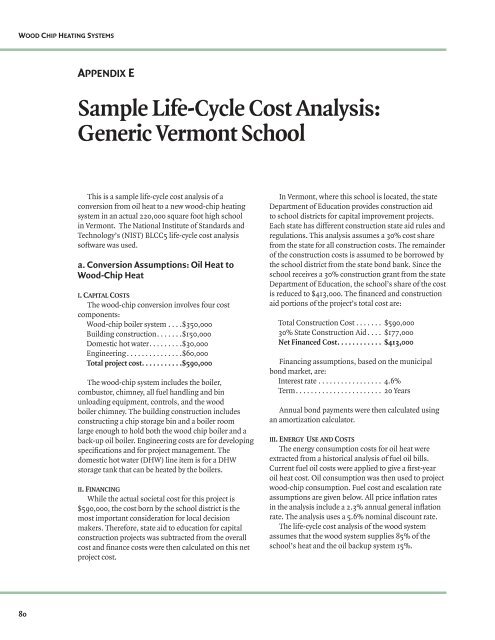Wood-Chip Heating Systems - Biomass Energy Resource Center
Wood-Chip Heating Systems - Biomass Energy Resource Center
Wood-Chip Heating Systems - Biomass Energy Resource Center
Create successful ePaper yourself
Turn your PDF publications into a flip-book with our unique Google optimized e-Paper software.
WOOD CHIP HEATING SYSTEMS<br />
80<br />
APPENDIX E<br />
Sample Life-Cycle Cost Analysis:<br />
Generic Vermont School<br />
This is a sample life-cycle cost analysis of a<br />
conversion from oil heat to a new wood-chip heating<br />
system in an actual 220,000 square foot high school<br />
in Vermont. The National Institute of Standards and<br />
Technology’s (NIST) BLCC5 life-cycle cost analysis<br />
software was used.<br />
a. Conversion Assumptions: Oil Heat to<br />
<strong>Wood</strong>-<strong>Chip</strong> Heat<br />
I. CAPITAL COSTS<br />
The wood-chip conversion involves four cost<br />
components:<br />
<strong>Wood</strong>-chip boiler system . . . .$350,000<br />
Building construction . . . . . . .$150,000<br />
Domestic hot water . . . . . . . . .$30,000<br />
Engineering . . . . . . . . . . . . . . .$60,000<br />
Total project cost . . . . . . . . . . .$590,000<br />
The wood-chip system includes the boiler,<br />
combustor, chimney, all fuel handling and bin<br />
unloading equipment, controls, and the wood<br />
boiler chimney. The building construction includes<br />
constructing a chip storage bin and a boiler room<br />
large enough to hold both the wood chip boiler and a<br />
back-up oil boiler. Engineering costs are for developing<br />
specifi cations and for project management. The<br />
domestic hot water (DHW) line item is for a DHW<br />
storage tank that can be heated by the boilers.<br />
II. FINANCING<br />
While the actual societal cost for this project is<br />
$590,000, the cost born by the school district is the<br />
most important consideration for local decision<br />
makers. Therefore, state aid to education for capital<br />
construction projects was subtracted from the overall<br />
cost and fi nance costs were then calculated on this net<br />
project cost.<br />
In Vermont, where this school is located, the state<br />
Department of Education provides construction aid<br />
to school districts for capital improvement projects.<br />
Each state has different construction state aid rules and<br />
regulations. This analysis assumes a 30% cost share<br />
from the state for all construction costs. The remainder<br />
of the construction costs is assumed to be borrowed by<br />
the school district from the state bond bank. Since the<br />
school receives a 30% construction grant from the state<br />
Department of Education, the school’s share of the cost<br />
is reduced to $413,000. The fi nanced and construction<br />
aid portions of the project’s total cost are:<br />
Total Construction Cost . . . . . . . $590,000<br />
30% State Construction Aid . . . . $177,000<br />
Net Financed Cost . . . . . . . . . . . . $413,000<br />
Financing assumptions, based on the municipal<br />
bond market, are:<br />
Interest rate . . . . . . . . . . . . . . . . . 4.6%<br />
Term . . . . . . . . . . . . . . . . . . . . . . . 20 Years<br />
Annual bond payments were then calculated using<br />
an amortization calculator.<br />
III. ENERGY USE AND COSTS<br />
The energy consumption costs for oil heat were<br />
extracted from a historical analysis of fuel oil bills.<br />
Current fuel oil costs were applied to give a fi rst-year<br />
oil heat cost. Oil consumption was then used to project<br />
wood-chip consumption. Fuel cost and escalation rate<br />
assumptions are given below. All price infl ation rates<br />
in the analysis include a 2.3% annual general infl ation<br />
rate. The analysis uses a 5.6% nominal discount rate.<br />
The life-cycle cost analysis of the wood system<br />
assumes that the wood system supplies 85% of the<br />
school’s heat and the oil backup system 15%.





